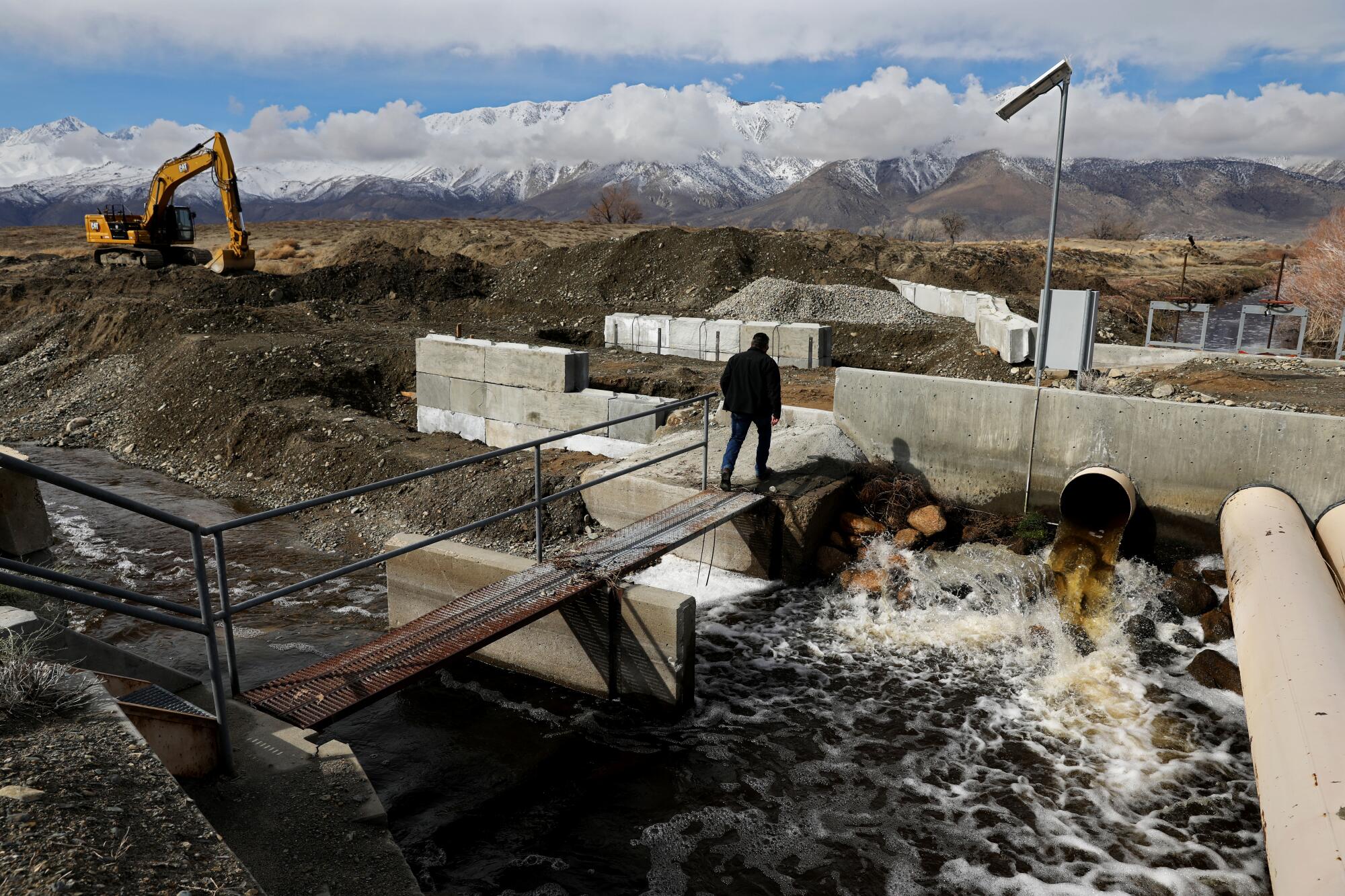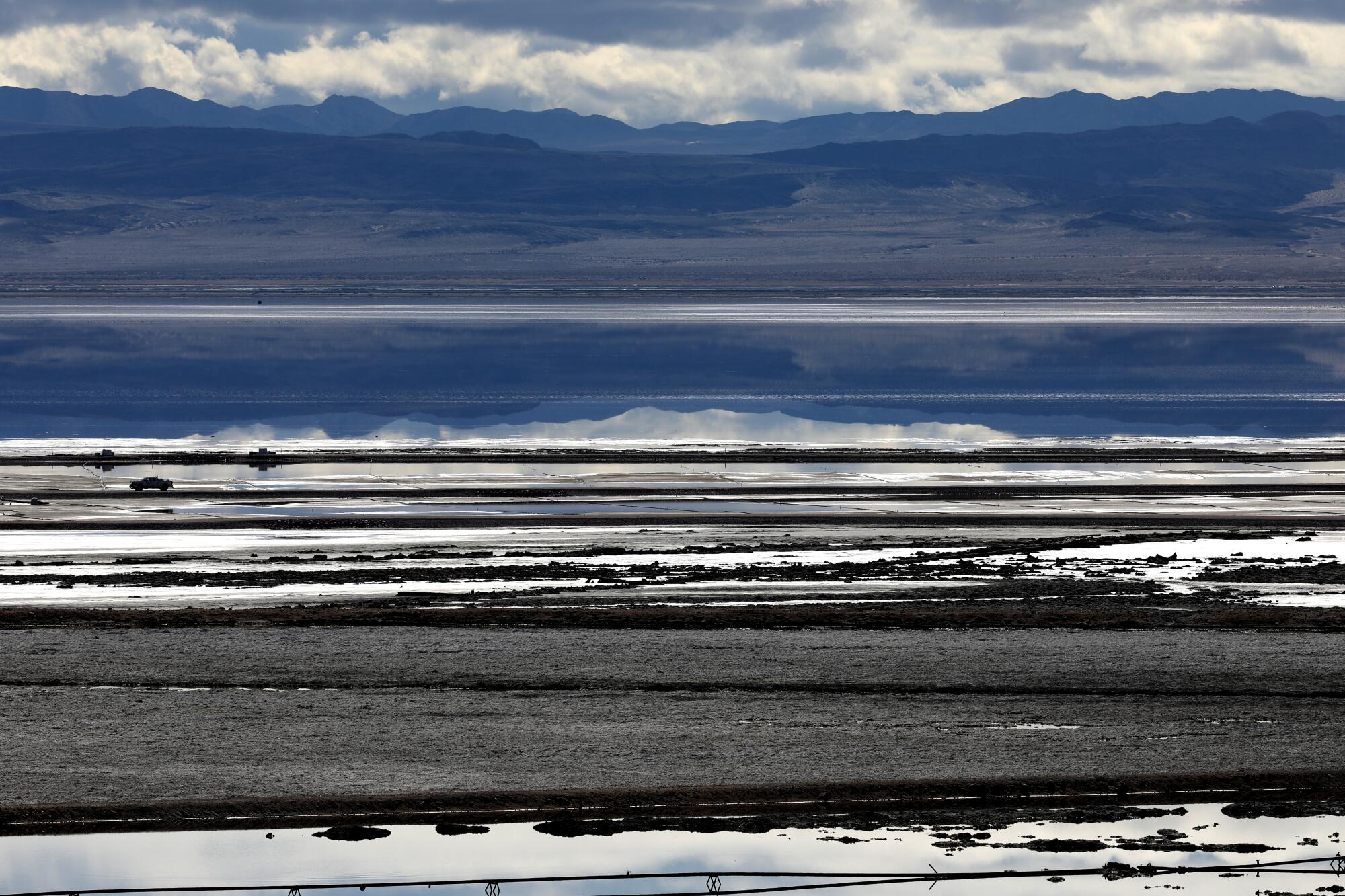
OLANCHA, Calif. — For more than 100 years, the Los Angeles Aqueduct has endured earthquakes, flash floods and dozens of bomb attacks as it wends and weaves through the canyons and deserts of the eastern Sierra Nevada.
But earlier this month, record storms accomplished the unthinkable when floodwaters undermined a 120-foot-long section of aqueduct in Owens Valley, causing its concrete walls to crumble.
“We’ve lost the aqueduct!” a Los Angeles Department of Water and Power inspector told his superiors by cellphone. As he spoke, chocolate-colored runoff and debris undercut the aqueduct just west of Highway 395 and the community of Olancha.
It was the first time in history that the 200-mile aqueduct had been breached by extreme weather, threatening water deliveries to 4 million ratepayers in Los Angeles.

It was also an indication of just how difficult it would be to defend the waterway against torrential runoff from a winter of near record snowpack. For weeks, DWP crews had been using heavy equipment and other means to control the anticipated spring runoff, but even longtime aqueduct workers were shocked by the suddenness of the break.
Among the first to arrive on the scene that March 10 morning was a team led by Ben Butler, senior aqueduct and reservoir keeper.

“Floodwater was coming down hard, creating a large, deep pool that pressed against the aqueduct’s walls,” he recalled. “We drove in as far as we could, then put on waders and headed for the breach.”
As historic storms fill once-dry Tulare Lake and submerge prime California farmland, tensions are building over how to handle the swiftly rising floodwaters.
For the next five days, rescuing L.A.’s water lifeline became the DWP’s highest priority as all hell broke loose in Owens Valley.
Traditionally dry rocky arroyos and ditches were overrunning their banks; irrigation diversions and culverts were buried in mud the consistency of peanut butter. At Pleasant Valley Dam, about 8 miles north of the city of Bishop, stormwater laden with sediment was surging over its spillway and into the Owens River at a rate of 1,000 cubic feet per second.

“We were already in an all-hands-on-deck mode when we learned that the aqueduct was in serious trouble,” said Adam Perez, deputy manager of aqueduct operations. “By 3 p.m. that afternoon, we came up with a game plan to prevent further deterioration, patch the breach and maintain service.”
As an emergency action, the DWP opened aqueduct spill gates 25 miles north to drain the damaged section and make repairs.
Those massive releases were not without consequence however. Freed water flooded ranches on the valley floor, as well as a half-mile stretch of state Highway 136, just south of the community of Lone Pine, and surged toward spreading grounds in Owens Lake, where it caused more problems.
The lake, which was once navigated by steamboats, had evaporated into dusty salt flats after the aqueduct was completed in 1913. In recent years, the DWP has spent $2.5 billion on projects designed to prevent the lakebed’s health-damaging particulate matter from becoming airborne.
But as aqueduct inflows washed over the playa, they dissolved alkaline minerals there, creating a vast corrosive brine pool that could ruin some of the dust control projects, officials said.
Over all, it took more than 100 DWP personnel working nonstop for nearly a week to repair the aqueduct. Their work included replacing damaged concrete walls and coating them with a special mix of cement, sand, fibrous material and adhesives that dry faster and harder than conventional concrete.

“It wasn’t easy managing that many boots on the ground in a short amount of time amid unfavorable conditions,” Perez said. “Ultimately, the damage did not affect any communities in the area.”
Nodding appreciatively toward the cargo of Sierra snowmelt flowing high and fast through the repaired section of channel on Thursday, he added, “Our crews did a great job.”
Looking ahead, he said, DWP inspectors will be stepping up daily patrols of its aqueduct systems and dams in Owens Valley.
In the wake of the crisis however, critics are pointing to the breach and subsequent flooding of the valley floor as signs that the DWP is losing control of its massive and complex aqueduct infrastructure amid climate-driven weather extremes.
As record snows saddle the eastern Sierra Nevada, snowmelt threatens to inundate Los Angeles Department of Water and Power infrastructure.
A singular feat of civil engineering and deception, the aqueduct has both spurred the phenomenal growth of Los Angeles and inspired deep-seated suspicions about the city’s motives that linger to this day in Owens Valley.
Most of its water is diverted from the Owens River, which ran through a valley that was inhabited for thousands of years by Paiute Indians before white settlers occupied their lands.

In 1905, city of Los Angeles agents posing as ranchers and farmers acquired most of the land and water rights in Owens Valley and construction of the system of tunnels, conduits and reservoirs began in 1907.
By the early 1920s, tensions seethed in the area over the city’s continuing acquisitions. Over a three-year period, the aqueduct was dynamited more than a dozen times.
On Sept. 15, 1976, a dynamite blast ripped apart one of the Alabama Hills aqueduct gatehouse’s five gates, flushing 100 million gallons of water into the valley floor.
Today, the chatter at local cafes and watering holes is over whether the DWP will be up to the task of managing levels of flooding expected this spring and summer.
Some residents are encouraged by the sight of caravans of DWP-owned earth movers and dump trucks loaded with boulders and mud rumbling to and from flood zones.
“We’ve had a lot of rain, snow and temperature swings lately,” said Dan Siegel, owner of the Merry-go-Round restaurant in Lone Pine. “I think the DWP has been doing a fine job when you consider how many places are in need of its equipment and manpower.”
As for predictions of potentially massive flooding when temperatures climb into the 80s and 90s, “We won’t know how much trouble we’re in until we know how fast the snow is melting,” Siegel said.
The DWP’s system is starting to show signs of age. In recent years, several stretches of the aqueduct system have been drained to allow replacement of cracked and bulging sections of century-old concrete.
Since severe storms began lashing the eastern Sierra region in January, the DWP has been relying on tactical strategies developed during epic rainfall that ended a five-year drought in 2017.

DWP crews are racing to clean out clogged culverts, divert excessive runoff into pasturelands and sage plains, and build berms to steer flood water from small towns straddling U.S. Highway 395 including Olancha, Cartago, Lone Pine, Big Pine and Bishop.
Gazing at snow-clad Sierra peaks to the west, Perez said, “If all that snow comes down hot and heavy when the weather warms up, the challenge will be to protect Owens Valley’s communities from flooding.”
There is a silver lining to the situation, however: For the first time in six years, Los Angeles can expect to receive a majority of its water from the aqueduct at least through late fall, Perez said.

Only a year ago, at the tail end of the worst drought in 1,200 years, the aqueduct was delivering about 13% of the city’s water supplies, with much of the rest purchased from the State Water Project and the Colorado River.
Watch L.A. Times Today at 7 p.m. on Spectrum News 1 on Channel 1 or live stream on the Spectrum News App. Palos Verdes Peninsula and Orange County viewers can watch on Cox Systems on channel 99.











